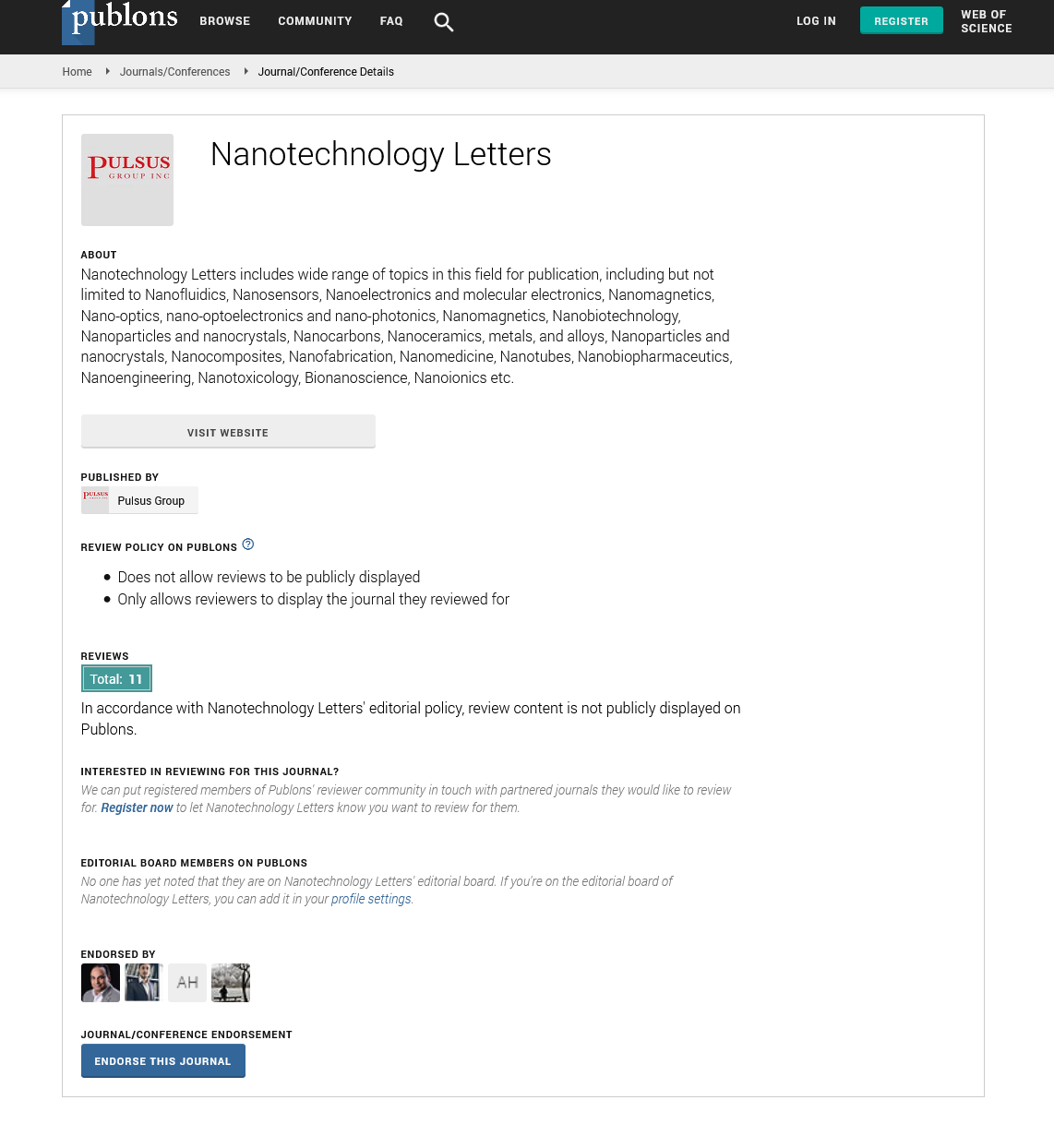THz medical imaging with nanotechnology assistance
Received: 12-Jun-2023, Manuscript No. pulnl-23-6811; Editor assigned: 18-Jun-2023, Pre QC No. pulnl-23-6811 (PQ); Accepted Date: Jun 27, 2023; Reviewed: 20-Jun-2023 QC No. pulnl-23-6811 (Q); Revised: 25-Jun-2023, Manuscript No. pulnl-23-6811 (R); Published: 29-Jun-2023
Citation: Watson. S. THz medical imaging with nanotechnology assistance Nanotechnol. lett.; 8(3):46-47
This open-access article is distributed under the terms of the Creative Commons Attribution Non-Commercial License (CC BY-NC) (http://creativecommons.org/licenses/by-nc/4.0/), which permits reuse, distribution and reproduction of the article, provided that the original work is properly cited and the reuse is restricted to noncommercial purposes. For commercial reuse, contact reprints@pulsus.com
Abstract
Terahertz (THz) medical imaging, supported by nanotechnology, represents a burgeoning frontier in medical diagnostics and imaging. This innovative approach capitalizes on the unique properties of THz radiation, enabling non-invasive, high-resolution imaging of biological tissues. By incorporating nanoscale materials and devices, THz imaging gains exceptional sensitivity, specificity, and precision. This article provides a concise overview of the potential of THz medical imaging with nanotechnology assistance, outlining its transformative capabilities in the realms of disease detection, early diagnosis, and personalized medicine. Through this review, we explore the interdisciplinary collaboration of THz technology and nanoscale materials, which promises to reshape the future of healthcare by offering unprecedented insights into the human body and its pathologies.
Key Words
THz; Biomaterials; Blood-brain barrier; Cancer; Chemotherapeutic engineering
Introduction
One of the most recent and captivating frontiers in the fields of technology and science is nanotechnology, a domain with the potential to reshape our daily lives as we know them. While it may be challenging to pinpoint the exact origins of nanotechnology, it is widely acknowledged that R. Feynman's inspirational lecture titled "There is plenty of room at the bottom" on December 29, 1959, serves as a cornerstone for this field. Many believe that this lecture, which was groundbreaking for its time, marked the inception of the nascent scientific discipline of nanotechnology.
The significance of nanotechnology hinges on the imperative need to characterize material dimensions at the nanometer scale, which, in turn, elucidates their unique properties. Materials exhibit entirely novel physical phenomena or possess distinct properties at such minuscule dimensions. At this scale, the behavior of matter deviates significantly from what is conventionally understood, giving rise to newfound and extraordinary characteristics. Factors such as the augmented surface area per unit volume and the dominance of quantum mechanics over classical physics, which governs macroscopic scales, contribute to these distinctive attributes. Consequently, nanotechnology encompasses both these novel, innovative physical attributes and the constraints imposed by small dimensions.
Numerous scientists are intrigued by the profound transformative potential of nanotechnology, and some even ponder whether it might instigate the forthcoming "nano-industrial revolution" owing to its burgeoning applications. Within the realm of medicine, nanotechnology, often referred to as "nanomedicine," holds great promise. The convergence of nanotechnology and medicine gives rise to the emerging field of nanomedicine, which aims to enhance existing treatments and medical procedures. Nanomedicine's significance to humanity has elevated it to a pivotal subfield within the domain of nanoscience, particularly in three vital areas: diagnosis, therapy, and regenerative medicine, positioning it as one of the most formidable challenges in twenty-first-century healthcare.
The expansive field of medical imaging and radiology is poised to derive inevitable benefits from a domain teeming with possibilities. Ever since the discovery of X-rays, various non-invasive imaging modalities have been developed, resulting in a diverse landscape in medical imaging. Each modality possesses unique attributes, whether in terms of ionizing or non-ionizing nature, sensitivity, resolution, complexity, data acquisition time, physical principles, performance metrics, available information, or associated costs. Each modality also carries its own distinct characteristics and inherent limitations.
Particularly noteworthy is the growing interest in non-invasive and non-ionizing radiation for medical imaging, marking a revolutionary shift in imaging techniques. Such methods, devoid of ionizing radiation, mitigate patient risks, facilitate repeatable imaging, are often painless, and reduce patient discomfort. Addressing the gap between microscopy and conventional medical imaging, current research efforts are concentrated on developing non-ionizing modalities that can bridge this divide. Among these innovative methods, Terahertz imaging emerges as a compelling contender. THz radiation, often referred to as 'sub-millimeter radiation' or 'T-rays,' occupies the frequency range between 100 GHz and 10 THz, residing in the gap between Infrared and microwaves. Despite its intriguing properties and manifold potential applications, this portion of the electromagnetic spectrum remained underexplored for an extended period due to the absence of suitable sources, whether electronic or optical. The advancement of THz radiation technology has been spurred by the evolution of semiconductor microfabrication processes and the development of ultra-short optical pulse lasers.
Nanotechnology, with its inherent capabilities, holds the potential to enhance therapeutic techniques and imaging technologies in the field of medicine. Many of the proposed applications transcend the limitations of current nanotechnology methods. The objective of this study is to assess the prospective real-world uses of THz imaging modalities empowered by nanotechnology. THz imaging, reliant on non-invasive radiation and regarded as one of the most enticing emerging imaging modalities, is yet to gain universal acceptance. To achieve this, it is imperative to initially recognize the deficiencies and constraints of state-of-the-art THz imaging setups.
CURRENT STATUS
The subsequent section provides a concise overview of the current state of THz imaging, highlighting the constraints of these specialized imaging techniques. In the subsequent section, we delineate the results of an extensive examination into how nanotechnology can bolster THz imaging. In our quest for pertinent information during the review process, we harnessed electronic resources, encompassing renowned online databases such as Scopus, Web of Science, and PubMed. Additionally, we conducted searches using Google and Google Scholar to explore other sources of information. Furthermore, we extended our search by considering the references cited within the original articles. The pursuit of relevant studies was guided by a set of keywords and indexing terms, including "terahertz nanoscopy," "terahertz imaging," and "nanotechnology/nanoscience.
The rapid proliferation of applications for THz radiation is imbued with exceptional potential and holds substantial societal relevance. These applications can extend beyond the realms of medicine, science, and pharmaceuticals to encompass material non-destructive testing and security. Of particular significance are biomedical applications, wherein the utilization of THz radiation for imaging and spectroscopic research could bring about substantial clinical advancements. Notably, since the introduction of the first biological THz imaging in 1995, an innovative non-invasive imaging technique has emerged. In THz medical imaging, the contrast is derived from the fact that different biological tissues exhibit distinct absorption spectra and refractive indices when interacting with THz waves. Consequently, this technology facilitates the acquisition of images and data that distinguish between healthy and pathological tissues. From the initial imaging demonstration by Hu and Nuss, it was elucidated that the contrast mechanism could be attributed to variations in the water content of two distinct tissues, such as porcine muscle and fat. Preliminary experiments have further revealed that the metabolic and morphological characteristics of the tissue contribute to creating contrast in images produced using THz pulses.
APPLICATIONS
Terahertz medical imaging holds immense promise in various applications due to its ability to provide non-invasive, high-resolution imaging. Some key applications of THz medical imaging include:
• Cancer detection: THz imaging can help in the early detection of skin cancers, breast tumors, and other cancerous tissues. It is particularly useful for identifying cancerous cells with different water content compared to healthy tissue.
• Wound assessment: THz imaging aids in the assessment of wound healing, allowing healthcare professionals to monitor tissue regeneration and the effectiveness of treatments.
• Dental imaging: It can be used for non-invasive imaging of dental structures, detecting cavities, assessing enamel health, and evaluating dental restorations.
• Bone health: THz imaging can be used to study bone density and the structural integrity of bones, making it a potential tool for osteoporosis assessment.
• Pharmaceutical research: It is utilized in the study of drug delivery and the penetration of pharmaceutical substances through the skin, providing insights for the development of new drug formulations.
LIMITATIONS
While Terahertz (THz) medical imaging offers numerous advantages, it also has certain limitations and challenges that need to be considered. Some of the key limitations of THz medical imaging include:
• Limited tissue penetration: THz waves have relatively low penetration depth in biological tissues. They are primarily absorbed by water, which limits the ability to image structures deep within the body. This restricts its application for imaging organs and tissues located beneath the skin.
• Image resolution: While THz imaging can provide highresolution images of surface and near-surface tissues, it may not offer the same level of detail as other imaging modalities like MRI or CT scans for deeper tissues.
• Scattering and absorption: THz waves are highly sensitive to scattering and absorption by various biological materials. This can make it challenging to obtain accurate and clear images in the presence of multiple tissue layers or complex biological structures.
• Long imaging times: THz imaging can be time-consuming, particularly for large areas or detailed scans. This can be a limitation when quick diagnostic results are required.
• Lack of commercial systems: Compared to established imaging technologies like X-ray or MRI, THz imaging systems are less common and not as readily available in clinical settings. This can limit its accessibility for routine medical use.






